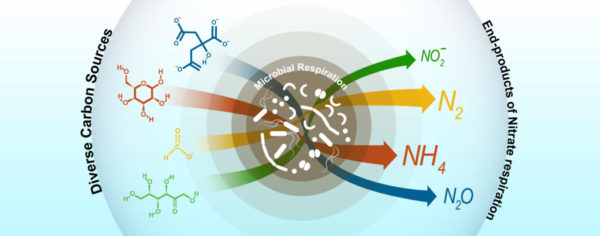
The world’s population relies on nitrogen fertilizer to maintain productive agricultural ecosystems. However, as a consequence of industrial fertilizer use the nitrogen cycle has become the most anthropogenically perturbed element cycle, and nitrogen contamination of surface waters and groundwater has serious consequences for public and environmental health. For example, nitrate in water supplies can cause methemaglobinemia, nitrate in coastal waters leads to eutrophication, and incomplete denitrification drives the accumulation of nitrous oxide, a potent greenhouse gas.
The nitrogen cycle is driven by microbial activity, but we lack a predictive understanding of how varying environmental conditions interact with microbial communities to influence the fate of nitrogen in the environment. This observation motivated recent work by ENIGMA researchers at Berkeley Lab. In a recent publication in the ISME Journal, the authors write, “Such a framework would enable better monitoring and management of microbial communities to mitigate environmental damage while maximizing the productivity of agricultural lands.” The ENIGMA team investigated how different carbon sources influence the end-products of microbial nitrate respiration, a critical juncture in the nitrogen and carbon cycles. The team’s approach leverages high-throughput DNA sequencing and laboratory automation capabilities at Berkeley Lab to combine genome-resolved metagenomics with high-throughput cultivation, colorimetric assays and amplicon sequencing of low complexity microbial communities. “We found that some carbon sources tend to favor nitrate reduction to ammonium which maintains nitrogen in soils, while other carbon sources favor denitrification which leads to loss of nitrogen as dinitrogen gas” says the lead author on the study, Hans Carlson.
The work adds nuance to a prevailing paradigm in the scientific literature: that higher concentrations of carbon will always favor nitrate reduction to ammonium.”Thermodynamic calculations predict that higher concentrations of carbon will favor nitrate reduction to ammonium. We cannot argue with thermodynamics” says Carlson, “however, the pathways for utilization of specific carbon sources are unevenly distributed with different nitrate reduction pathways in different microbial genomes. Therefore, in some environments, a particular carbon source may be utilized only by microbes that reduce nitrate to produce dinitrogen. In these environments, no amount of carbon added will induce nitrate reduction to ammonium”
Carlson hopes to extend the team’s approach to more microbial processes and environments. “By linking microbial gene content with activity in low-complexity microbiomes in high-throughput, we will be able to better predict how complex, variable environmental parameters influence microbial element cycling.” Ultimately, this could have real benefits for how industrial ecosystems are managed, for instance, by identifying selective carbon amendments to stimulate nitrate reduction to dinitrogen to could enhance the removal of remove nitrogen from wastewater and contaminated groundwater or to stimulate ammonium accumulation in agricultural soils.
Reference:
Carlson, H.K.; L.M. Lui, M.N. Price, A.E. Kazakov, A.V. Carr, J.V. Kuehl, T.K. Owens, T. Nielsen, A.P. Arkin, A.M. Deutschbauer (2020) Selective carbon sources influence the end-products of microbial nitrate respiration. International Society for Microbial Ecology Journal. [doi]:10.1038/s41396-020-0666-7
